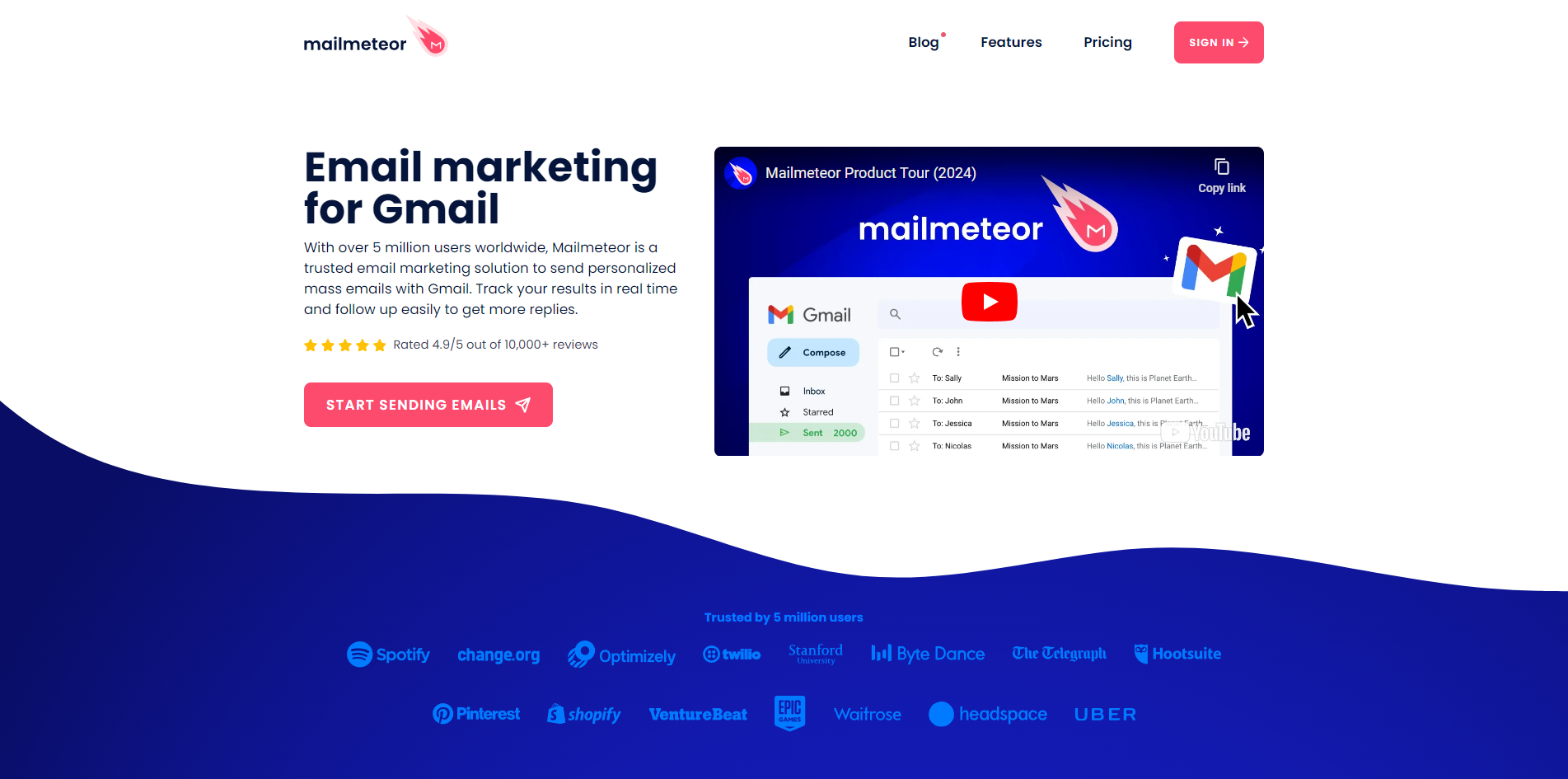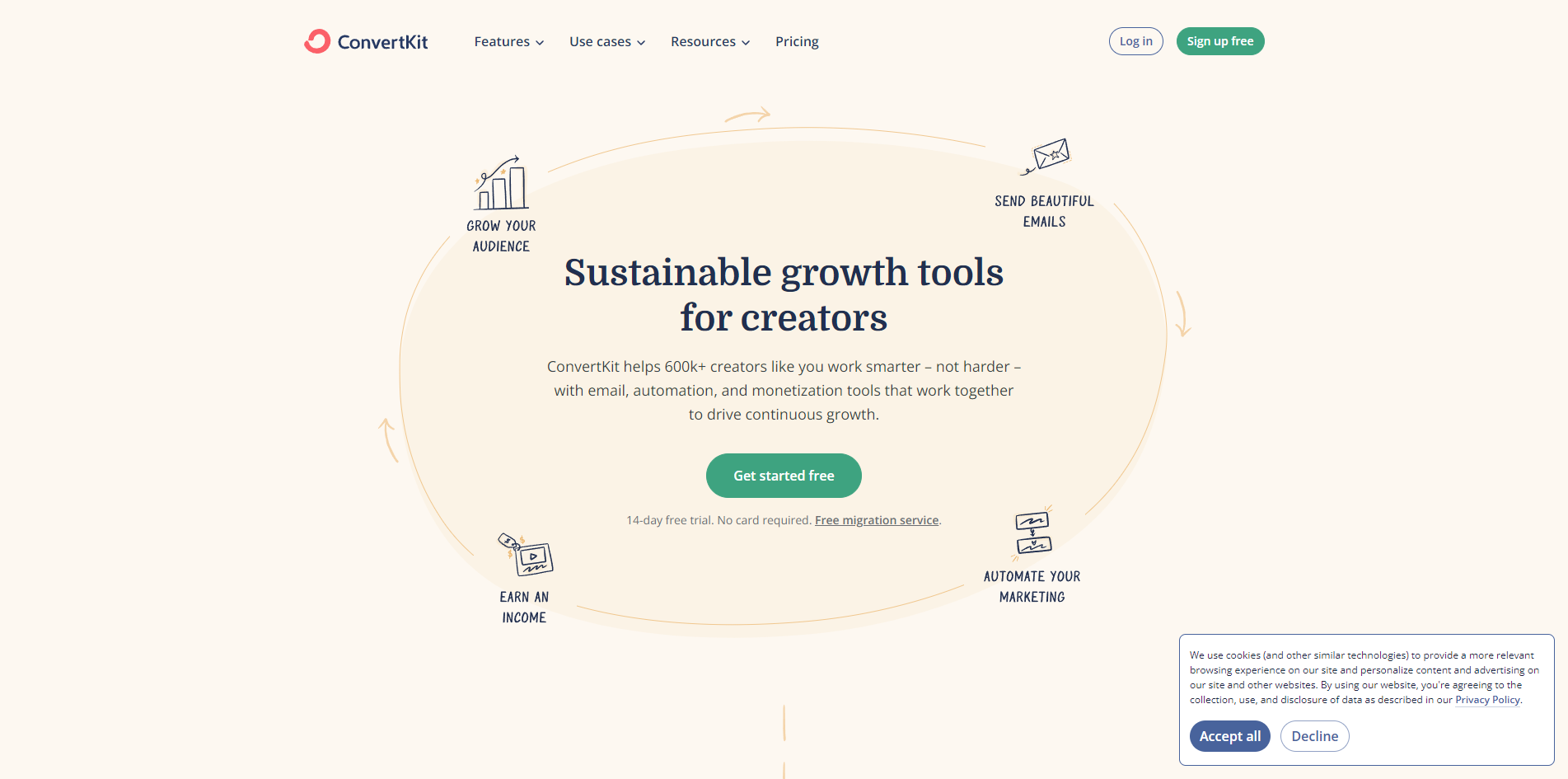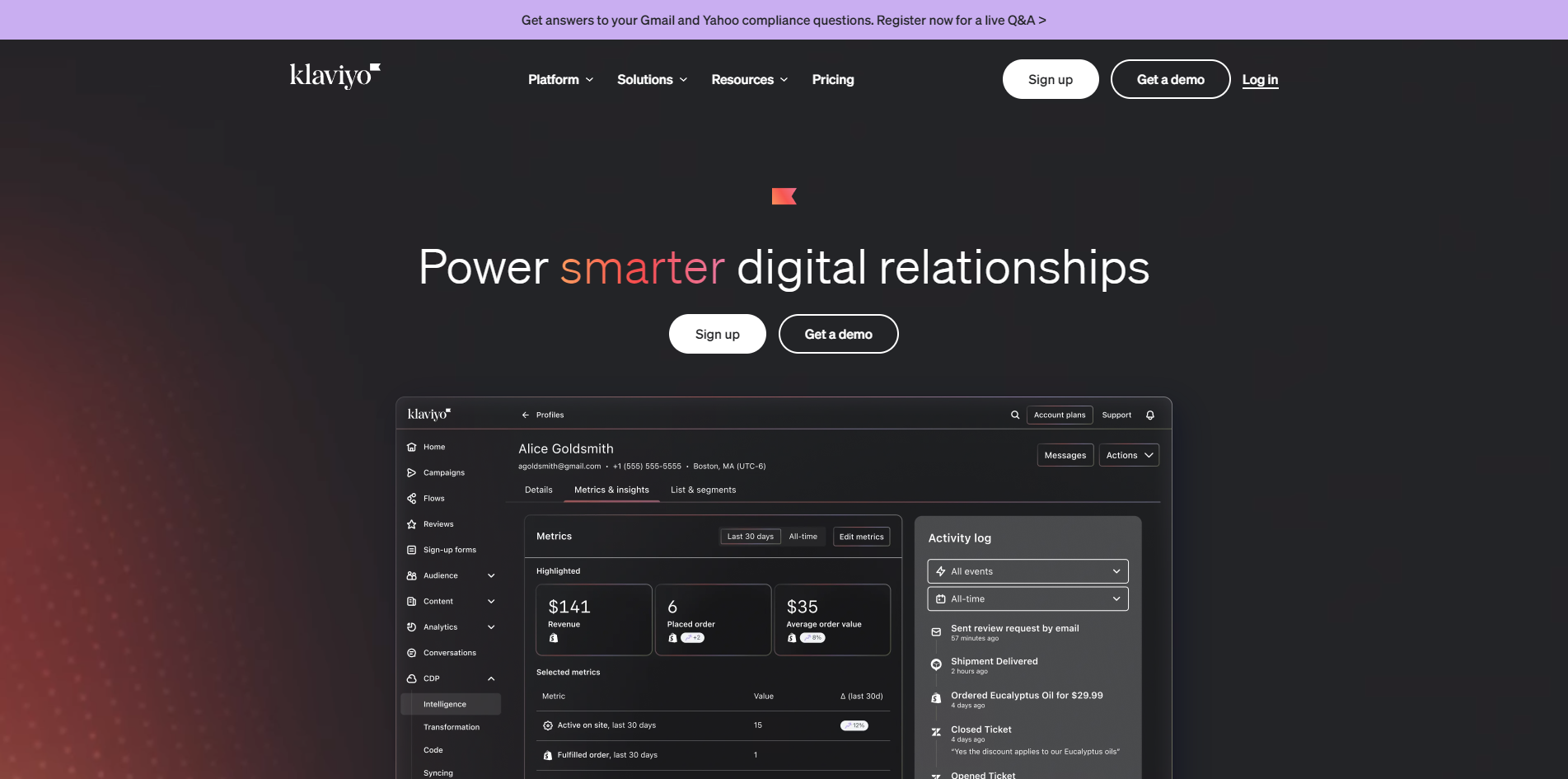Mailchimp was once one of the most popular email marketing platforms that businesses far-and-wide considered to be a go-to for creating and managing email campaigns. It offers a wide range of features, including email templates, campaign automation, and email analytics. But it is no longer the clear-cut winner it once was, especially for people interested in a more specialized solution for their needs.
In this article, we will explore some alternatives to Mailchimp that may better suit your email marketing needs depending on your specific needs.
1. Mailmeteor

Mailmeteor is a powerful email marketing tool meant to seamlessly integrate with Gmail and superpower your campaigns. It offers users a sleek and intuitive dashboard, or the ability to launch personalized email campaigns directly from a Gmail extension or straight from Google Sheets. Mailmeteor is designed for privacy, deliverability, and efficiency with advanced features like personalization, schedule send, autopilot, BounceShield, follow-up, and many more, you can focus on creating compelling emails.
- Email Personalization: Personalize your emails for each recipient, improving engagement by adding a personal touch to your messages. Ideal for cold email campaigns and general marketing outreach campaigns.
- High Deliverability Rates: Mailmeteor uses your existing Gmail or Google Workspace account to send its bulk emails, ensuring they land in the inbox and stay far from the spam folder. Mailmeteor optimizes send times and adheres to Gmail’s sending limits on its own, so you can rest in peace while autopilot schedules and sends your emails for you.
- Tracking and Analytics: Provides detailed insights into how recipients interact with your emails, including open rates, click rates, and bounce rates. Lets you optimize your email campaigns by identifying patterns in the data.
- Affordable Pricing: Mailmeteor offers its service at affordable prices, including a generous free tier, making it accessible for businesses and individuals working on a tight budget.
While Mailmeteor strikes a balance between functionality and ease of use, it is not meant to run large-scale newsletter campaigns nor is it able to send your transactional emails for you. Let us look at other alternatives for those features.
| Pros of Mailmeteor | Cons of Mailmeteor |
|---|---|
| Email Personalization: Lets you add a personal touch to your bulk emails, resulting in better engagement. | No Transactional Email: Not suitable for transactional emails or newsletter subscriptions. |
| High Deliverability Rates: Sends email through your Gmail/Google Workspace account, staying clear of spam filters. | Dependent on Gmail’s Sending Limits: Not suitable for users with very high-volume needs beyond Gmail’s limits. |
| Google Integration: No need to leave your Gmail account to send bulk emails. | No Multi-Channel Support: Focuses only on email, lacks SMS / Phone integrations. |
| Tracking and Analytics: Offers basic email analytics such as open rates, click rates, and bounce rates for you to optimize your future campaigns. |
2. Brevo, formerly Sendinblue
 Best for people who want to send transactional emails as quickly as possible, Brevo offers a generous free tier for people who wish to start collecting emails as quickly as possible and worry about everything else later.
Best for people who want to send transactional emails as quickly as possible, Brevo offers a generous free tier for people who wish to start collecting emails as quickly as possible and worry about everything else later.
Here’s how Brevo holds up against Mailchimp:
- Pricing: Brevo does not charge based on the number of contacts on your list, neither does it put a cap on how many contacts you can have. You simply pay based on the number of emails you send. This is far superior to Mailchimp which also charges you for inactive subscribers and people who have not opted-in to receive emails from you.
- Automation: With a ton of advanced triggers based on various factors, including the recipient’s contact data and eCommerce activity, Brevo lets you automatically set up A/B tests, follow-up emails, abandoned cart reminders, and much more. All of this for free, something Mailchimp charges a significant fee for!
- Managing Multiple Lists: This is where Brevo wins without any competition, they let you segment and create lists from your contacts without any limitations. Mailchimp on the other hand does not let you send out a single email campaign to selective people in different lists, not to mention that they will charge you twice if you add a single subscriber to two lists.
| Pros of Brevo | Cons of Brevo |
|---|---|
| Flexible Pricing Model: Charges are based on the number of monthly emails that go out from your account, cost-effective for businesses with large contact lists who send emails less frequently. | Expensive for High-Volume Needs: For businesses who need to send daily email blasts to their customers, Brevo can easily end up being more expensive than Mailchimp. |
| Generous Free Tier: Almost all features are available in the free tier including advanced automation tools and the ability to run A/B tests, with a generous daily limit of 300 emails. | Lack of eCommerce Capabilities: Mailchimp is a far more mature product compared to Brevo and thus has a much better integration with the various eCommerce platforms such as WooCommerce and Shopify. |
| No Contact Limits: There are no caps on how many contacts you can have, allowing for scalability and growth without worrying about increasing costs due to your subscriber count. |
You can also read up on our pick for Brevo alternatives.
3. ConvertKit
 Built for creators and solopreneurs seeking simplicity, powerful automation, and subscriber management, ConvertKit streamlines the otherwise complex task of managing email marketing campaigns so that you can focus on what you do best, creating content.
Built for creators and solopreneurs seeking simplicity, powerful automation, and subscriber management, ConvertKit streamlines the otherwise complex task of managing email marketing campaigns so that you can focus on what you do best, creating content.
- Managing Multiple Lists: With almost the same capabilities as Brevo, ConvertKit lets you add tags to your contacts while also letting you segment them based on different criteria, it then lets you send emails however you want instead of being limited to your subscriber lists.
- Limited Analytics: This is where Mailchimp comes out as the obvious winner, ConvertKit only provides limited analytics and lacks a dedicated analytics dashboard.
- Pricing: Just like Mailchimp, ConvertKit also charges based on the number of subscribers you have, while the upfront pricing is similar, Mailchimp is far more expensive in the long run since they charge you for inactive subscribers as well as people who are yet to opt-in.
| Pros of ConvertKit | Cons of ConvertKit |
|---|---|
| Simplicity and Ease of Use: Designed for creators and solopreneurs, ConvertKit emphasizes simplicity to let you focus more on content creation. | Limited Analytics: Unlike Mailchimp, ConvertKit provides limited analytics and lacks a dedicated analytics dashboard. |
| Powerful Automation: Features powerful tools to automate email marketing campaigns, simplifying the process of managing otherwise complex workflows. | Targeted at Creators: Because of its focus on simplicity and content creators, ConvertKit lacks some of the more intricate features for businesses with complex marketing needs. |
| Easy Segmentation & Management: You can segment contacts using custom tags, enabling targeted and personalized email campaigns without being limited to traditional lists like Mailchimp. |
4. Omnisend
 Built for eCommerce users, Omnisend is powered with a bunch of tools designed to increase your sales and to help you build an audience. They feature a product picker that lets you pull products directly from your store and integrates itself with WooCommerce, Shopify, and BigCommerce to generate unique discount codes for your recipients.
Built for eCommerce users, Omnisend is powered with a bunch of tools designed to increase your sales and to help you build an audience. They feature a product picker that lets you pull products directly from your store and integrates itself with WooCommerce, Shopify, and BigCommerce to generate unique discount codes for your recipients.
- Fully Featured Free Tier: Something that is rarely found in the wild nowadays, Omnisend has a fully featured free tier that only has a few reasonable limitations on the number of contacts, emails, and web notifications you can send per month.
- Gamified Forms: Collecting emails is a lot easier if you give users something in exchange, but doing so with gamified forms has a far higher success rate than any other method. This is where Omnisend shines the brightest.
- eCommerce Focus: Every feature in Omnisend is developed with eCommerce in mind, from product recommendations based on previous purchases to customizing the communication channel (email vs SMS) based on a user’s prior history, Omnisend optimizes your customer journey better than any other email marketing platform out there.
| Pros of Omnisend | Cons of Omnisend |
|---|---|
| Fully Featured Free Tier: Omnisend’s free tier provides access to everything that the platform has to offer with some reasonable limitations on volume instead. | Platform Specific Integrations: While most small businesses will be using WooCommerce, Shopify, and BigCommerce, those on other platforms might find Omnisend incompatible with their workflow. |
| Gamified Forms: Embed innovative and engaging subscription forms that enhance user experience and improve conversion rates. | Focus on eCommerce: Businesses without a core focus on eCommerce might find Omnisend less aligned with their needs, given its specialized focus. |
| eCommerce Focus: Omnisend offers tailored eCommerce features that are difficult to replace, such as a product picker for email templates and unique discount code generation for your customers. |
5. Klaviyo
 Our last alternative to Mailchimp, Klaviyo is another big name in the world of eCommerce email marketing tools. It is primarily designed for big brands who need powerful features to integrate with their existing store to optimize and improve their conversion rates, but new and upcoming solopreneurs can make use of it just as much as the big leagues.
Our last alternative to Mailchimp, Klaviyo is another big name in the world of eCommerce email marketing tools. It is primarily designed for big brands who need powerful features to integrate with their existing store to optimize and improve their conversion rates, but new and upcoming solopreneurs can make use of it just as much as the big leagues.
- Difficult But Better: Klaviyo is meant for people who want to milk every bit of optimization possible out of their email marketing campaigns, meaning that it has a far more granular approach to email marketing compared to Mailchimp.
- Pricing: Both Klaviyo and Mailchimp use contact-based pricing, but how they count these subscribers is different. Klaviyo will only charge you once for each subscriber whereas Mailchimp will charge you for each list that a subscriber is present on.
- Shopify Integrations: Klaviyo offers in-depth Shopify integrations, directly collecting customer data and purchase history from Shopify without the need for any third-party application.
| Pros of Klaviyo | Cons of Klaviyo |
|---|---|
| Precise Segmentation: Offers a more detailed approach to email marketing for businesses looking to maximize every aspect of their campaigns. | Complexity: Klaviyo can be difficult to navigate for beginners or those not seeking an in-depth approach. Especially given its emphasis on taking a precise approach to email marketing. |
| Shopify Integration: Provides a seamless and deep integration with Shopify, utilizing customer data and purchase history to offer the best email marketing capabilities natively. | eCommerce Focus: While its focus on eCommerce is a plus for some, those without an eCommerce business might find these features unnecessary for their use-case. |
Choosing Your Mailchimp Alternative
While Mailchimp is still known as one of the most mature solutions out there, it is no longer the default recommendation for newcomers. Mailchimp has had several price hikes in the past and there are other tools in the market that charge less for feature sets that are a lot more focused and optimized for different scenarios.
- Mailmeteor: If you only plan to run Cold Outreach or other Mass Email campaigns, then there is no need to invest in any solution other than Mailmeteor. It integrates directly with various Google services and does not require any complicated setup whatsoever.
- Brevo: For users who wish to start sending transactional emails as soon as possible, Brevo offers a streamlined solution with well-documented tutorials for developers who wish to send transactional emails from their apps.
- ConvertKit: For content creators who want a set-it-and-forget-it system to manage their subscribers without the need for any complicated setups, ConvertKit has you covered.
- Omnisend & Klaviyo: If eCommerce is what you do, then both solutions will give you a considerable edge over your competitors as far as your email and SMS marketing efforts are concerned.



